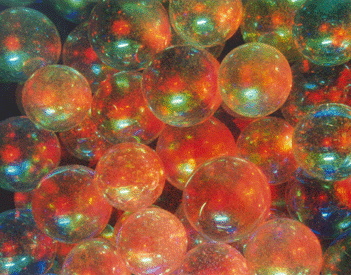A new laser that emits different wavelengths at different temperatures could be used in fields ranging from optoelectronics to remote heat sensing. Diederik Wiersma and Stefano Cavalieri of the University of Florence in Italy exploited the temperature-dependent structure of liquid crystals to control the optical behaviour of their ‘random’ laser, which need only be tens of micrometres across (D Wiersma and S Cavalieri 2001 Nature 414 708).

Conventional lasers are based on a mirrored cavity filled with an optically active material. The substance – excited by an electrical current or another laser – emits light, which the mirrors reflect back into the cavity, stimulating more light emission. This amplification step is crucial for the production of intense radiation with a single wavelength.
But the laser developed by Wiersma and Cavalieri is a ‘random’ laser – so-called because amplification is achieved by the random diffusion of light in a laser material. As light scatters through the structure, it excites other atoms and makes them emit light. This is a ‘distributed cavity’, in which the material itself plays the role of the reflecting cavity, and there are no mirrors.
In a random laser, the degree to which light can scatter through the material determines the level of gain in the laser. If the light is strongly scattered, it is trapped for longer and can stimulate greater emission. This leads to a higher gain and greater light intensity.
Wiersma and Cavalieri realised that they could adjust the amount of gain by controlling how strongly the laser material scatters light. To do this, they filled a porous glass structure with laser dye dissolved in a liquid crystal. Liquid crystals are chain-like molecules that align to a different degree depending on their temperature. As the degree of alignment changes, so does the diffusion coefficient of the overall structure.
“The laser is made of compressed powdered glass, and it looks white because light scatters through it at random”, explains Wiersma. “The space between the many tiny glass grains is filled with the liquid crystal and the laser dye”.
At temperatures well below 35 degrees centigrade, Wiersma and Cavalieri found that the laser emitted extremely intense light with a very narrow range of wavelengths, around 610 nanometres. But as they increased the temperature, the intensity gradually fell and the range of wavelengths became broader. Laser action ceases at 42 degrees, which corresponds to a phase transition in the liquid crystal. At this point, the intensity dropped sharply and emission spectrum became very flat and broad.
The range of temperatures over which the laser is sensitive can be adjusted by changing the combination of glass and liquid crystal. According to Wiersma and Cavalieri, this could make it suitable for a wide variety of applications.


